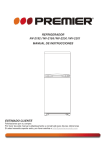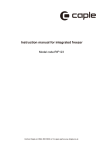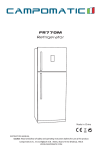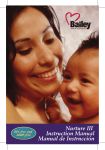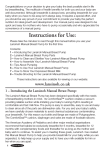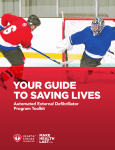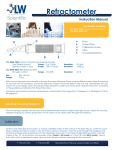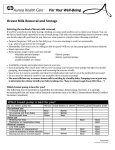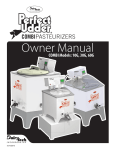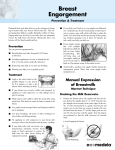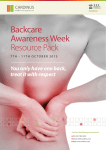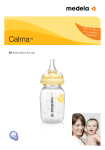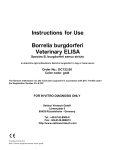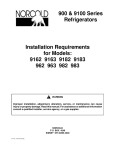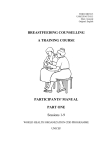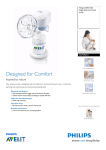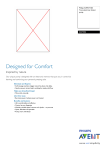Download Expressing and Storing Breastmilk
Transcript
FA CT S H E ET Expressing and Storing Breastmilk Learning how to express breastmilk is an important skill for all mothers. Expressing breastmilk allows you to: • Rub some milk onto your nipples to keep them moist and prevent infections. • Give your baby a taste of milk to make her interested in feeding if she is sleepy. • Soften your areola to allow your baby to get latched. • Collect and store milk to feed your baby when you cannot be with her. Expressing Breastmilk You can practice expressing breastmilk as soon as your baby is born or even before. In the first 2-3 days after birth, you will get a small amount of colostrum, maybe 5-10 ml (1-2 teaspoons) or less. Expressing milk by hand is also convenient and free. Whether you are hand expressing or using a pump, it may take a few minutes for your milk to flow. At times, your milk will come faster, then slower, then faster again. This is normal. You may have 3-6 let-downs of milk from each breast. It will probably take 10 - 15 minutes to remove most of the milk from each breast. With practice, you will find out what works best for you. Getting ready When you are ready to express your milk. Relax so that your milk will flow easily. You can try some or all of these things to see what works best for you. • Always wash your hands before expressing milk for your baby. • Put a warm, wet cloth around your breasts, or have a shower to start the let-down reflex that helps your milk flow. • Choose a place where you are comfortable. You may want a place where you have privacy. • Relax by thinking about your baby, listening to music, or watching something you enjoy on television. • Massage your breasts to help the milk to come down. There are different ways to do this. You can massage in a circular motion with your fingers together. Or, you can support your breast with one hand, and stroke the other side of your breast firmly with your other hand. Always go from the chest towards the nipple, and work all around the breast. • Lean forward and gently shake the breast • Gently roll your nipple with your thumb and finger. www.beststart.org 2013 This document has been prepared with funds provided by the Government of Ontario. 1 FA CT S H E ET Expressing by hand • Use a clean container with a wide opening. Put it on a surface in front of you or hold it under your breast to collect the milk. • Hold your breast with one hand, not too close to the nipple. The thumb and fingers of your hand should be opposite each other and about 2 ½ – 4 cm (1 to 1½ inches) back from the nipple. Lift your breast slightly, and gently press the breast inwards toward your chest. • Lightly compress your thumb and fingers together in a rolling motion towards the nipple. • Relax for a few seconds, then repeat the same motion. Do not squeeze the base of your nipple, as this will stop the flow of milk. • Move around your breast so you are emptying the entire breast. Continue this until the flow of milk has completely stopped. You may want to switch hands now and again. Moving back and forth from one breast to the other can help with the milk flow. It may help to massage the breast each time before you start. press (back towards your chest) compress relax Expressing with a pump If you decide to use a pump, you can choose a manual or an electric pump. There are good manual pumps. These are fairly inexpensive. Most manual pumps use either arm or hand action to create suction. If you have arm or hand problems, a manual pump might not work for you. Some mothers choose to purchase a pump. If you only need a pump for a few days or weeks, you can rent an electric pump. If you need a pump for a longer time because your baby is unable to feed at the breast, or you are going back to work, a double electric pump will save you time. Single electric pumps take 10-15 minutes to remove milk from each breast. A double pump removes milk from both breasts in 10-15 minutes. Battery pumps are not a good idea for long-term use because they lose pressure as the battery wears out. Whether you decide on a manual or an electric pump: • Check with other mothers to find out which pump worked well for them. • Choose one that lets you adjust the pressure from low to high. • Make sure it has a valve that prevents backflow. • Make sure it does not hurt. If it hurts, get help. www.beststart.org 2013 This document has been prepared with funds provided by the Government of Ontario. 2 FA CT S H E ET When you are using a pump, make sure your whole nipple area is right inside the funnel so that it won’t hurt. Some breast pumps allow you to choose funnels in different sizes. Choose one that is right for you. Adjust the pump to its lowest setting, and increase the pressure as your milk starts to flow. Use as much pressure as is needed to keep your milk flowing. None of this should hurt. A skilled professional can help you choose a pump that is right for you. Reasons for Expressing Breastmilk You may need to express and store breastmilk to feed your baby for different reasons: • If your baby is not able to breastfeed. • If your breasts are too full. • If you need to give your baby extra breastmilk. • If you are going to be away from your baby. Expressing milk when your baby is not able to breastfeed If your baby is sick or born prematurely, it may not be possible to breastfeed right away. Begin expressing your milk within 6 hours of giving birth. Ask your nurse for help to get started. In the first 2-3 days after birth, your breasts produce colostrum. Colostrum is rich in antibodies and nutrients. It is an excellent food for newborns and gives your baby’s immune system an important boost. You should express about 8 times during every 24 hour period, until your baby is breastfeeding efficiently directly from your breasts. Express your milk at least once during the night because this is when milk production is greatest. Expressing regularly, during the day and at least once at night will make sure that you have a steady supply of milk. “ It took me 6 weeks to get my baby boy to breastfeed. I had to pump and feed him breastmilk while we both learned to breastfeed. It was nice to have the support. Something so natural, it’s not always easy, but you can learn, if you have the right resources, support and lots of patience. ” Expressing milk when your breasts are too full Sometimes, when your breasts are too full, you may want to express some milk. Some babies find it difficult to latch when the breasts are full. If your baby will not latch, express enough to soften the area around your nipple. This will allow your baby to latch well and feed more efficiently. If your breasts are uncomfortable, express enough to make them comfortable. As your baby learns to feed well, your breasts will soften over time and before long, your breasts will produce the right amount of milk for your baby. www.beststart.org 2013 This document has been prepared with funds provided by the Government of Ontario. 3 FA CT S H E ET Expressing milk if your baby needs extra breastmilk Sometimes there is a reason your baby needs extra breastmilk. She may be sleepy during feeds, not be gaining enough weight or born a little early. You can offer your baby your own expressed breastmilk after she has breastfed. Expressing milk after each feed will also increase your supply and soon your baby will not need the extra breastmilk. Expressing milk when you have to be away from your baby While you are away from your baby, be sure to express milk each time your baby will feed. If you don’t express your milk regularly while you are away from your baby, you could end up with blocked ducts or mastitis. For more information on Blocked Ducts or a Breast Infection go to: www.beststart.org/resources/breastfeeding/index.html. Some mothers like to store some breastmilk as a backup supply. If you want to store some extra breastmilk, you can express milk when your breasts are fullest, usually in the morning. Your milk supply will adjust and produce the extra milk for you to store. If you have trouble getting your milk to flow, try pumping one breast while your baby breastfeeds on the other. You will probably find that the amount you get depends on the time of day and whether you are tired or stressed. If you want to express more milk, take a break and then try again. Before long, you will know what works best for you. Storing Breastmilk Fresh breastmilk is better for your baby than frozen breastmilk. Thawed, frozen breastmik, still has many benefits. How long you can safely store breastmilk depends on where you store it, and whether your baby is healthy or sick. Sick or premature babies in hospital need to be protected from harmful bacteria. Parents must be especially careful how they store breastmilk. If you are expressing breastmilk for a sick or premature baby in hospital: • Always put your milk in the refrigerator within 1 hour of expressing it. • Do not store milk longer than 2 days in the refrigerator. • You baby may not be able to feed because he is sick or too small. Freeze it for when he is ready. • Label your milk clearly with your name and the date and time www.beststart.org 2013 This document has been prepared with funds provided by the Government of Ontario. 4 FA CT S H E ET Storage ti mes for h ealthy babies wh o are at h ome If you are expres sing for a baby at ho healthy fu me, store ll-term breastmilk following using the guidelines : • At room temperatu re: 3 – 4 h • Cooler w ours ith a freez e r p a c k • Fresh m : 24 hours ilk in refrig erator: 3 – • Thawed 5 days milk in re frigerator: • Freezer 1 day that is ins ide a refrig • Refrigera erator: 2 w tor freezer eeks (separate • Deep fre d o o r) : 3 – 6 mo ezer: 6 – 1 nths 2 months Use clean glass or hard plastic containers that are BPA free or bags made for freezing breastmilk. Do not use baby bottle liners because they often break. Mark the date you expressed the milk on the container and use milk in the order of the date it was expressed. Throw out any milk that is older than the storage times given above. Store breastmilk in the amounts your baby needs for one feeding. If you don’t express enough milk for a full feeding, you can add smaller amounts of milk together, as long as you cool all the milk before you combine it. Then use the milk according to the oldest date. Store breastmilk near the back of the refrigerator where it is coldest. Don’t store it in the fridge door where it is not as cold. When freezing milk, leave a 1.5 cm (1/2 inch) space at the top of the container. It will expand when it freezes. If you are using a bag, don’t seal it until after the milk has frozen. If you have a self-defrosting freezer, place the milk on a shelf, because the bottom of the freezer warms up when it is defrosting. www.beststart.org 2013 This document has been prepared with funds provided by the Government of Ontario. 5 FA CT S H E ET Thawed milk Thawed milk may taste or smell different than fresh breastmilk. It can also look slightly blue, yellow or brown, depending on what the mother has eaten. • Thaw frozen breastmilk for 8-12 hours in the refrigerator, or under cool and then warm running water. • When it is thawed gently shake it to mix in the fat. • Throw away any breastmilk which has been thawed longer than 24 hours. Cleaning It is important to clean your breast pump and the containers used to store breastmilk so that it is safe for your baby. • After each use, clean the parts of the breast pump that have come in contact with your breastmilk. Wash them with hot soapy water, rinse and air dry them. • Wash the containers you used to collect and store milk, using hot soapy water. Scrub them with a bottle brush, rinse and air dry them. How to feed expressed breastmilk to your baby • Whenever possible, use fresh breastmilk. • Heat the container of breastmilk by placing it in a bowl of warm water. Do not use a microwave, and do not heat it on the stove. These methods can cause hot spots that can burn your baby’s mouth, and also destroy some key ingredients in breastmilk • Throw out any milk your baby does not finish at a feeding. • You can cup or spoon feed your baby expressed breastmilk. • If you would like more information or help contact your local public health unit, your health care provider or a lactation consultant. “ When you compare the amount of time you breastfeed to your child’s whole life, it is worth investing the time and effort it takes to give them the best start possible. ” www.beststart.org 2013 This document has been prepared with funds provided by the Government of Ontario. 6






